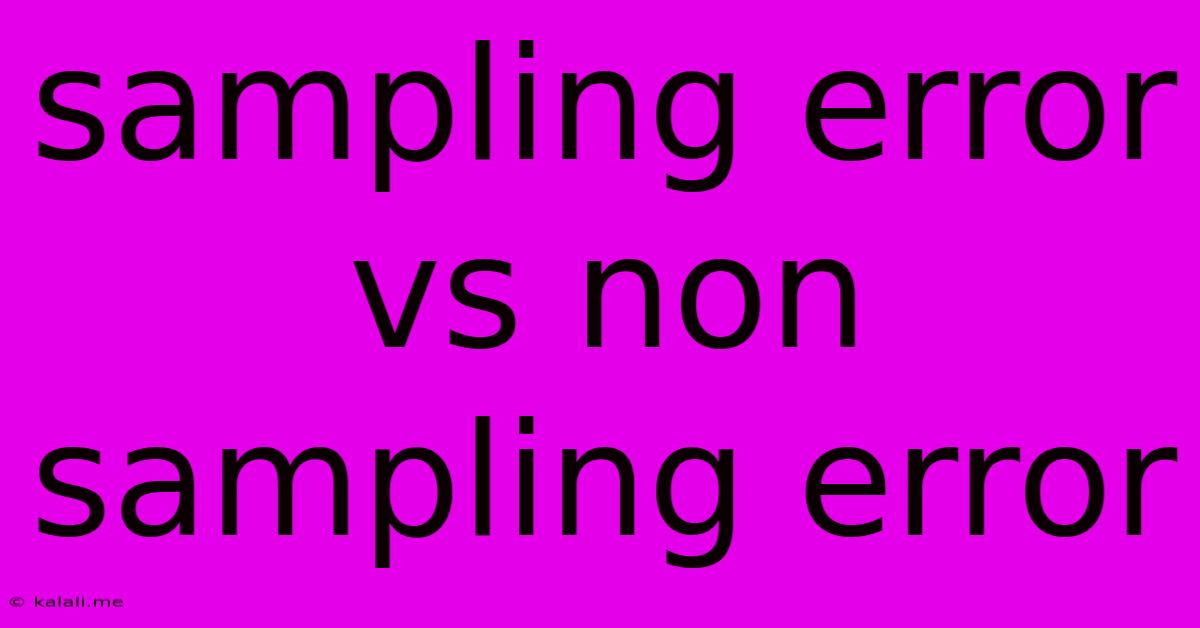Sampling Error Vs Non Sampling Error
Kalali
Jun 13, 2025 · 4 min read

Table of Contents
Sampling Error vs. Non-Sampling Error: Understanding the Differences
Understanding the difference between sampling error and non-sampling error is crucial for anyone involved in data collection and analysis, particularly in research and surveys. Both types of errors can skew results, leading to inaccurate conclusions. However, their sources and nature differ significantly. This article will delve into the specifics of each, explaining their causes, consequences, and how to minimize their impact.
Meta Description: This article explains the key differences between sampling error and non-sampling error, examining their causes, consequences, and mitigation strategies for accurate data analysis.
What is Sampling Error?
Sampling error arises from the inherent variability in selecting a sample from a larger population. It's the difference between the results obtained from a sample and the true results that would be obtained if the entire population were studied. This error is random and inevitable whenever you use a sample instead of the entire population. Imagine trying to determine the average height of all adults in a country – it's impractical to measure everyone. Using a sample will inevitably lead to a slightly different average than the true population average.
Causes of Sampling Error:
- Sample size: Smaller sample sizes generally lead to larger sampling errors. The larger the sample, the closer it tends to represent the population.
- Sampling method: The method used to select the sample significantly impacts the error. A poorly designed sampling method, like convenience sampling, is more prone to introducing significant errors than a probability sampling method like stratified random sampling or cluster sampling.
- Population variability: A highly variable population (e.g., income levels) will have a larger sampling error than a less variable population (e.g., height within a specific age group).
Minimizing Sampling Error:
- Increase sample size: A larger sample provides a more accurate representation of the population.
- Use appropriate sampling techniques: Employing probability sampling methods reduces bias and improves accuracy.
- Stratification: Divide the population into relevant subgroups (strata) and sample from each to ensure representation of all segments.
What is Non-Sampling Error?
Non-sampling error, on the other hand, encompasses all errors that are not related to the sampling process itself. These errors can occur regardless of whether you're using a sample or the entire population. They are often systematic and can significantly bias your results.
Causes of Non-Sampling Error:
- Measurement error: Errors in data collection, such as inaccurate instruments, poorly worded questions in a survey (leading to response bias), or observer bias (where the observer influences the results). Consider a faulty scale used to measure weight; this would introduce measurement error.
- Coverage error: This occurs when the sampling frame (the list from which the sample is drawn) doesn't accurately represent the population. For example, using a phone directory to sample the population will exclude people without landlines.
- Non-response error: This arises when a significant portion of the selected sample doesn't participate in the study. Those who don't respond might have different characteristics than those who do, biasing the results.
- Processing error: Errors during data entry, coding, or analysis can lead to inaccuracies. This can involve simple typos or more complex mistakes in data manipulation.
Minimizing Non-Sampling Error:
- Careful questionnaire design: Use clear, unambiguous questions to avoid misinterpretations. Pilot test your questionnaire.
- Well-trained interviewers: Ensure interviewers are properly trained to administer the survey consistently and accurately.
- Data validation and cleaning: Thoroughly check and clean the data to identify and correct errors.
- High response rates: Implement strategies to maximize participation rates, such as follow-up calls or incentives.
- Use multiple data sources: Triangulate your findings by using different methods or datasets to increase confidence in the results.
Sampling Error vs. Non-Sampling Error: A Summary
| Feature | Sampling Error | Non-Sampling Error |
|---|---|---|
| Source | Sampling process | All other sources during data collection and analysis |
| Nature | Random, inevitable | Systematic, avoidable (to some extent) |
| Impact | Affects precision of estimates | Affects accuracy and validity of results |
| Mitigation | Increase sample size, improve sampling method | Improve data collection methods, data validation |
By understanding the differences between sampling and non-sampling errors, researchers can develop strategies to minimize their impact and improve the accuracy and reliability of their findings. Addressing both types of errors is essential for obtaining meaningful and trustworthy results from any data analysis endeavor.
Latest Posts
Latest Posts
-
What Seismic Wave Travels The Fastest
Jun 14, 2025
-
What Is The Difference Between Physical Map And Political Map
Jun 14, 2025
-
What Is The Antonym Of Wise
Jun 14, 2025
-
Which Word Or Phrase Does Not Belong With The Others
Jun 14, 2025
-
Which Atmospheric Gas Absorbs The Most Terrestrial Radiation
Jun 14, 2025
Related Post
Thank you for visiting our website which covers about Sampling Error Vs Non Sampling Error . We hope the information provided has been useful to you. Feel free to contact us if you have any questions or need further assistance. See you next time and don't miss to bookmark.